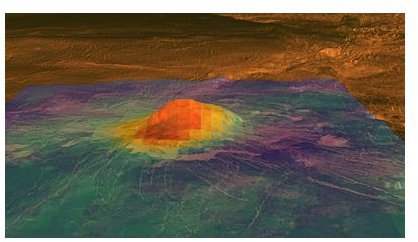The Surface Temperature of Venus--Why is it so Hot?
A Celestial Hothouse
Talk about global warming. Venus has it in spades. On the surface the temperature is 900 degrees F. In its atmosphere, the temperature below 55 km is about 400 degrees F. Then at 55 km there is a strange and severe temperature inversion, with the temperature varying from about 80 degrees F at some 55 km to -190 degrees F at 90 km.
Part of the reason for this planetary hothouse is Venus’ thick cloud cover and atmosphere. Consisting mainly of carbon dioxide (CO2), Venus’ atmosphere carries the greenhouse effect to the extreme. As the environmentalists keep warning, a buildup of CO2 in our atmosphere could increase Earth’s temperature to unbearable levels. It has on Venus.
Add the thick cloud cover which also helps hold heat in, and you have a world that can never cool off. In fact, the European Space Agency’s (ESA) Venus Express probe has found that there is very little difference in day and night time temperatures on the planet.
Interestingly, the probe has found that only about 10 percent of the Sun’s radiation penetrates the clouds and gets to the surface. But 100 percent what does reach the surface stays, because the greenhouse effect and clouds hold it in.
Heat from Within
Venus itself produces additional heat. The Venus Express has found extensive active volcanism on the planet. Myriad volcanoes are spewing heat and various compounds into the atmosphere.

One of those compounds is sulfuric acid. At about 60 km, there is a 20 km thick layer of clouds that is composed mainly of sulfuric acid. Because this acid is negatively charged, it produces great lightning storms that heat the atmosphere.
Some planetologists theorize that Venus’ interior is composed of highly radioactive material, and heat from the near nuclear reaction going on in the interior also heats the surface.
We do know Venus does not contain an iron core as does Earth, because it has no magnetic field. And that opens speculation about some other findings that ask another question.
How Did Venus Get Hot?
The more intriguing question regarding Venus’ fever is how it got that way. The Venus Express probe has detected water vapor in the upper layer of clouds, and hydrogen and oxygen in other layers—signs of water. There are also surface features that indicate Venus may once have been a much different world, with oceans and perhaps vegetation.
German researchers have identified rocks in some areas that look like granite. Granite is formed when basalt is forced beneath plates by tectonic forces, mixes with water and is pushed back to the surface by volcanic activity. The Venus Express has added one more piece to this puzzle. Radar imaging has indicated that Venus’ highland plateaus were once continents surrounded by oceans.
So where did the water go?
One clue is Venus’ lack of a magnetic field. The Venus Express has found that the side of the planet facing the Sun is bombarded by the solar wind. Without a protective magnetic field, the solar wind blows lighter elements in the atmosphere—hydrogen, oxygen, water—out into space. Venus lost a good deal of its atmospheric water in this way.
But what about the surface water? And where did all the CO2 come from? As the Venus Express researchers say, we will have to put a lander on Venus to answer those questions.
Sources
ESA Venus Express site: https://www.esa.int/SPECIALS/Venus_Express/index.html
NASA: https://www.nasa.gov/worldbook/venus_worldbook.html
Images:
Venus’ cloud cover: https://starchild.gsfc.nasa.gov/docs/StarChild/solar_system_level2/venus.html
Venusian volcano : https://www.esa.int/SPECIALS/Venus_Express/SEMUKVZNK7G_0.html
